Hydrogen Energy System and Heat Utilization Technology
Introductory Video of H2 and Heat Utilization System Team
 "Efficient Use of Renewable Energy through Hydrogen"
"Efficient Use of Renewable Energy through Hydrogen"
Renewable Energy-derived Hydrogen Production
[ YouTube 3'30 ]
Overview
With the start of the Feed-In Tariff, a large amount of renewable energy have been installed in recent years. However, due to inadequate adjustment of the balance of supply and demand and inadequate capacity of transmission lines, there have been many limitations. They include output restrictions, resulting in the generation of renewable energy that will not be used, and there is concern that this will further increase in the future. Also, in order to suppress CO2 emissions, the reduction of CO2 emissions from buildings to zero is importantant. These mismatches must be eliminated and it is necessary to make the best use of renewable energy.
Research Target
Our team is now engaged in the research and development of energy systems that make the best use of hydrogen and heat totally from power generated from renewable energy to satisfy demand, in order to convert renewable energy that cannot be effectively utilized with conventional technology into hydrogen, and make the best use of the thermal energy generated. In particular, we are developing individual technologies such as hydrogen production and hydrogen storage, and demonstrating hydrogen and thermal energy systems utilized these technologies.
Research Outline
- As a hydrogen production technology, the team is aiming for high efficiency with original technology that directs DC power from photovoltaic systems to the water electrolyzer by controlling the number of electrolysis cells.
- As a hydrogen storage technology, the team is developing hydrogen storage systems that use metal hydride. In order to promote the use of hydrogen in urban areas, we are developing an inexpensive, safe, and large-scale hydrogen storage method that is not subject to the High Pressure Gas Safety Act and Fire Service Act, by using metal hydride that can storage hydrogen under a pressure of less than 1 MPa and does not ignite.
- The team is developing new hydrogen compression technology and refining technology for wider utilization of hydrogen.
- In order to further improve the functionality of these technologies, the team is developing and demonstrate thermal power generation and thermal storage technology for effectively using solar heat and unused waste heat.
- In order to achieve realizing zero-emission from buildings, a hydrogen energy utilization system controlled by BEMS (building energy management system) has been developed under Shimizu-AIST collaborated research projects (Shimizu-AIST Zero Emission Hydrogen Town Cooperative Research Laboratory). The developed hydrogen system, we named “Hydro Q-BiC”, was relocated to Koriyama comprehensive regional wholesale market. Demonstration at the management building has been started to reduce the CO2 emission and enable practical applications.
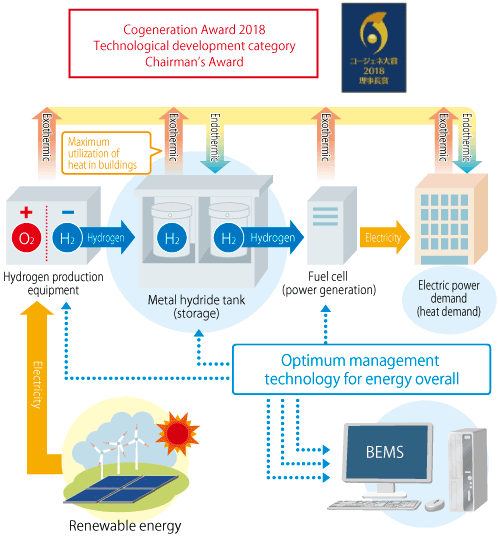 【Fig. 1】Outline of energy system demonstration using BEMS
【Fig. 1】Outline of energy system demonstration using BEMS
-under-development_200.png) 【Fig. 2】Hydrogen separation membrane (PdCu alloy) under development
【Fig. 2】Hydrogen separation membrane (PdCu alloy) under development
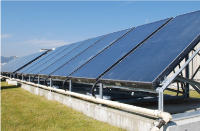 【Fig. 3】Solar heat collection apparatus
【Fig. 3】Solar heat collection apparatus
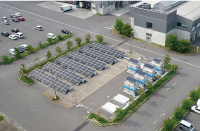 【Fig. 4】Shimizu-AIST Zero Emission Hydrogen Town Cooperative Research Laboratory
【Fig. 4】Shimizu-AIST Zero Emission Hydrogen Town Cooperative Research Laboratory
Main Research Facilities
Direct Coupled Photovoltaic-Electrolyzer System
A 20 kW solar cell is connected directly to the water electrolyzer. The water electrolyzer is capable of switching the number of electrolysis cells and following the maximum power point of the solar cell. We are also attempting to smooth the fluctuation of solar radiation by connecting lithium ion capacitors (LiC).
Various Analyzers
Examples: field emission scanning microscope, X-ray diffractometer, PCT characteristic evaluator, hydrogen-permeable membrane evaluator, surface tensiometer, thermal conductivity meter, thermal analysis device (TG-DTA/DSC).
.png) 【Fig. 5】Field emission scanning electron microscope (FE-SEM)
【Fig. 5】Field emission scanning electron microscope (FE-SEM)
High Pressure Hydrogen Facility
The high-pressure hydrogen facility includes a high-pressure hydrogen supply booster (≦90 MPa), accumulator (≦90 MPa, 200 L), bundle of hydrogen cylinders (≦19.6 MPa, 1,250 L), high pressure/high temperature reaction vessel (≦100 MPa, ≦200 ℃), and solar thermal panels. We conduct demonstration tests on heat-driven hydrogen compression with metal hydride and solar heat. The hydrogen produced from renewable energy in the bundle of cylinders can be supplied to a station and used for a fuel-cell vehicle.
100 kW Class AC Simulator and Simulation Load
This equipment can simulate single-phase 200 V, and three-phase 200 V and 400 V grids. In addition, it is possible to simulate changing frequency and voltage, short circuit test (FRT).
Activities and Achievements
Water Electrolysis Degradation Prevention Technology
The team has succeeded in converting approximately 15% of solar energy into hydrogen energy using 20 kW solar cells and a 5 Nm³/hour water electrolyzer. Electrolytic current that varies depending on the weather can be smoothed using lithium-ion capacitors, which makes it possible for the electrolyzers to have a longer lifespan.
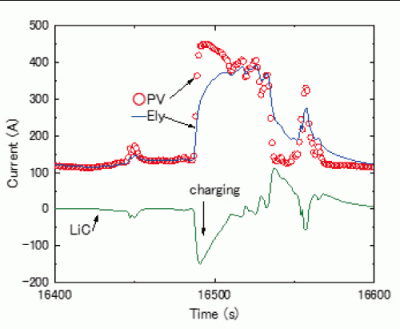 【Fig. 6】The capacitor charges the sudden current rise of the solar cells to smooth the current
【Fig. 6】The capacitor charges the sudden current rise of the solar cells to smooth the current
Safe Hydrogen Storage Technology(non-burnable metal hydride)
The team has developed an inexpensive metal hydride that does not use rare-earth elements. As shown in the photograph, even after repeated hydrogen absorption/desorption is performed, it does not ignite. It is therefore alloy that is not designated as a hazardous material under the Fire Service Act (certified).
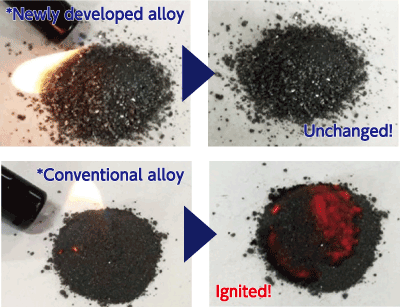 【Fig. 7】Hazardous material check of metallic powder (ignition test)
【Fig. 7】Hazardous material check of metallic powder (ignition test)
High Pressure and Temperature PCT Measurement
It is possible to obtain PCT (pressure-composition-temperature) characteristics of metal hydride in high pressure and temperature range up to 100 MPa and 200 ℃. We succeeded in evaluating the hydrogen compression performance of BCC alloy, which is expected to be a non-hazardous heat-driven metal hydride compressor.
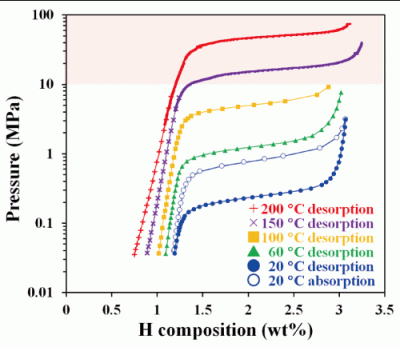 【Fig. 8】Hydrogen desorption properties of BCC alloy in high pressure and temperature range
【Fig. 8】Hydrogen desorption properties of BCC alloy in high pressure and temperature range
Team Member
| Title |
Name |
| Leader |
Akihiro Nakano (concurrent) |
| Senior Researcher |
Naruki Endo |
| Researcher |
Kiyotaka Goshoume |